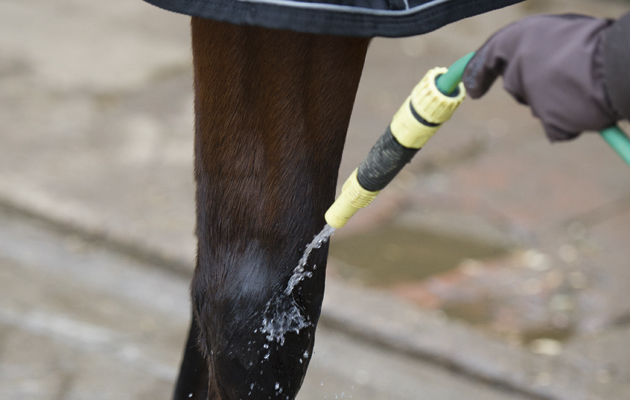The healing properties of water have long been recognised, but how does hydrotherapy relieve pain and promote physical fitness? David Rowlands MRCVS looks at the science behind a good soaking
The term hydrotherapy refers to the use of water — hot, cold, as steam or ice — to enhance health and wellbeing.
While simple cold hosing remains a tried and trusted remedy for tired or filled legs, many horse owners are using more sophisticated means of harnessing the healing powers of water. From ice boots and underwater training treadmills to state-of-the-art equine swimming pools, the modern horse world is awash with new therapeutic options.
But what can hydrotherapy accomplish? The health benefits for humans are well documented. Hydrotherapies such as water treadmill exercise and swimming are known to enhance cardiovascular and muscular function, decrease limb pain and inflammation, reduce limb loading and improve joint motion.
In the equine world, however, many questions are still to be answered. It is hoped that ongoing research will add scientific weight to the perceived beneficial effects of various aquatic therapies.

Valegro on the water treadmill at Hartpury being handled by Alan Davies
How does it work?
Hydrotherapy is based on the combined effect of five variables: buoyancy, viscosity, hydrostatic pressure, temperature and salt concentration.
Buoyancy is a lifting force. In horses, water at the level of the shoulder produces a 50-60% reduction in bodyweight. Increased buoyancy reduces the effects of loading forces on the joints and the surrounding muscles, tendons and ligaments. This helps reduce pain and inflammation, and encourages better joint motion.
Viscosity encourages greater use and control of muscles. Water is 800 times more viscous than air. The increased effort needed to move through water requires increased muscle activity, which improves muscle strength and joint stability.
Hydrostatic pressure facilitates neuromuscular (nerve and muscle) function by stimulating nerves and receptors in joints. This can reduce oedema (fluid swelling), enhance joint motion and relieve pain.
Temperature can have a dual effect. Warm water improves muscular blood flow and stimulates lymphatic drainage. Cold water reduces blood flow, lessening inflammation and pain.
Salt concentration delivers anti-inflammatory and pain-relieving effects. The osmotic effect of salt draws swelling from inflamed tissues.
In one study, horses with known lower limb injuries were stood in cold saltwater baths (5-9°C) for 10 minutes, three days a week, for four weeks. Healing of digital flexor tendon and suspensory ligament lesions was apparent, both clinically and on ultrasound scans. In the same study, visual improvements in the degree of soft tissue swelling were apparent within the first eight days.
Exercising a horse in water provides a medium in which these factors can be altered to tailor individual rehabilitation programmes for specific musculoskeletal conditions.

Using cold water and ice
The effects of cold therapy include constriction of blood vessels (vasoconstriction) and reduced blood flow, resulting in a decrease in bleeding and swelling. Nerve conduction is also lessened, reducing pain. A lower metabolic rate in turn reduces cell death from hypoxia (insufficient oxygen), which helps preserve tissue viability and can shorten healing time.
Cold therapy can be achieved via several methods, including hosing and ice packs. To be most effective, tissue temperatures must be reduced to between 15 and 19°C (tissue damage can occur when limbs are exposed to prolonged cold temperatures). Cold therapies can be effective to tissue depths of up to 4cm, depending on blood supply and fat thickness.
Timing is critical. Cold therapy is most effective when applied immediately after acute injury; after 48 hours the benefit is much less. During this 48-hour window, 10-20 minutes of cold hosing or iced water treatment is advised with breaks between sessions of between 30 minutes and four hours.
Commercial cold packs for horses are constantly evolving, although studies in the cooling of human skin have shown that the application of “wet ice” (chopped ice wrapped in a wet cloth) is at least as effective as “dry ice” (ice flakes in a plastic bag).

Total immersion or treadmill?
Swimming can have a cardio-respiratory benefit in equine fitness development. Horses are not natural swimmers, however, and not all will adapt well to this training method.
When swimming, a horse moves with an extended back posture.
In my experience racehorses tend to cope best with this, whereas some dressage horses and showjumpers that are trained to work in a flexed back outline may be less suited to this form of exercise.
An underwater treadmill is another fitness option, although the muscle patterns a horse uses on a treadmill are different to those on the ground. The horse is committed to the speed set by the apparatus, which may lead to compensatory changes in the way he moves and cause further issues.
When walked in the sea or through a river, a horse uses muscle patterns nearer to those of propulsion on land and can regulate his own speed.
Another important factor is the depth of the water. If this is kept quite low, the horse is encouraged to pick his feet up in a similar way to when doing pole work. Yet if the water is deep, the muscle pattern changes and horses are more prone to move with an extended back posture similar to that used when swimming.
Ref: Horse & Hound; 1 October 2015

